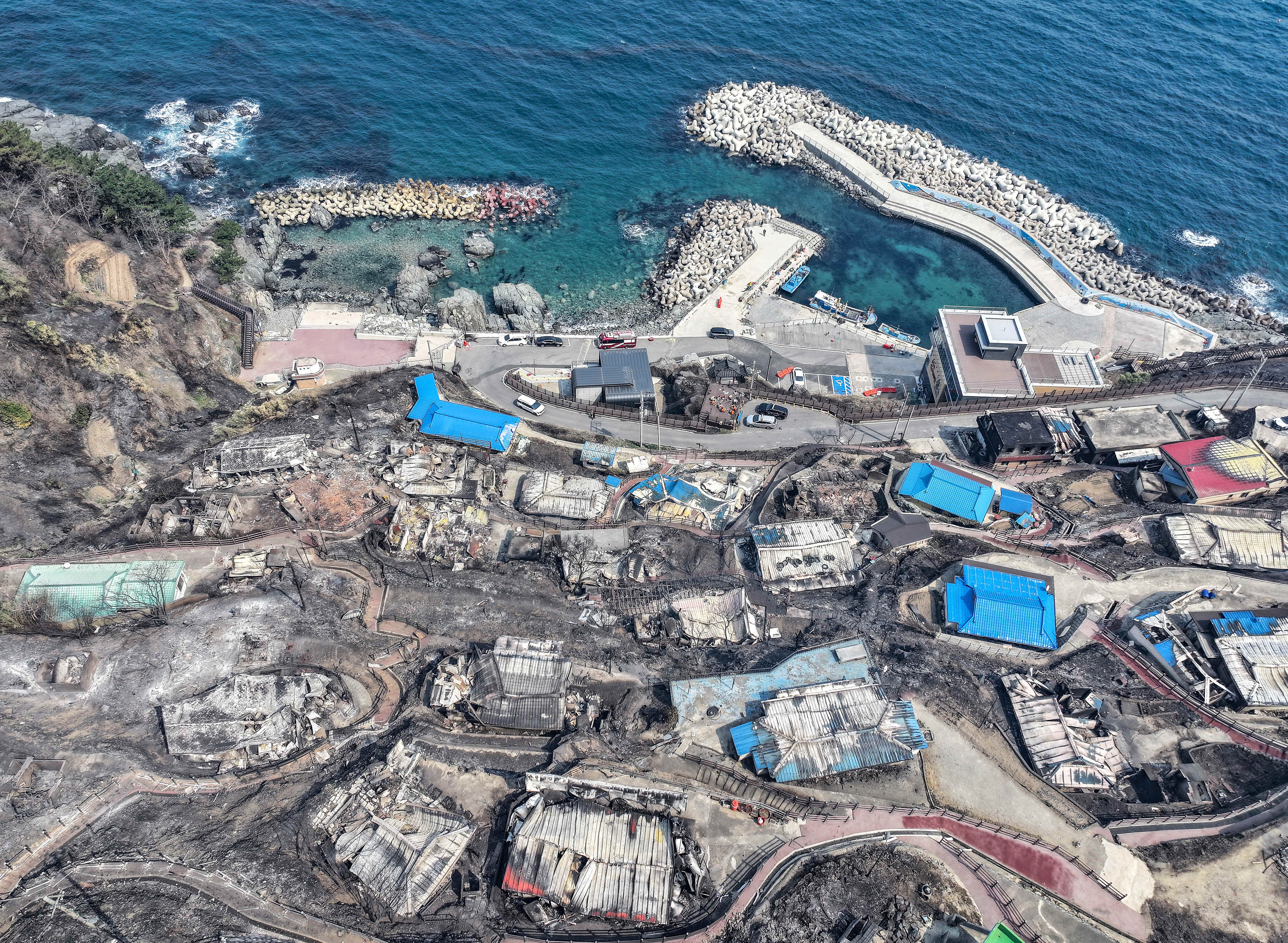Rain and cooler temperatures have brought some much-needed relief to South Korean firefighters battling the country's worst wildfires on record, but the largest blaze still isn’t fully contained.
The fires, which started on Friday last week, left at least 28 people dead, displaced over 30,000, and burned through nearly 48,000 hectares of land.
By this Friday morning, the flames were 85 per cent contained, Korea Forest Service chief Lim Sang-seop told a televised briefing.
The fires have destroyed hundreds of homes, factories, and ancient Buddhist temples, including a 7th century Gounda temple. Fire crews were focusing efforts on extinguishing the remaining blazes with the help of over 9,000 personnel, 125 helicopters, and hundreds of vehicles deployed across affected areas.
Two fires began on Friday, with the largest of the fires in Uiseong County, which rapidly spread eastward, torching forests and villages in Andong, Yeongdeok, and parts of Sancheong-gun, stripping hillsides down to smouldering ash.
According to the Korea Forest Service, a total of 47,860 hectares (118,265 acres) have burned so far, making this the largest wildfire event in South Korea’s history, surpassing the 2000 fire that destroyed 24,000 hectares.
Aerial photos and satellite images show large blackened patches across the region, particularly near Uiseong, where the firefront moved with astonishing speed, reaching the coastal town of Yeongdeok, 51km away, in just 12 hours earlier this week.

“Hazes have been diminished because of the rain last night, so that’s favourable for securing visibility,” said Lim Sang-seop, chief of the Korea Forest Service. “Also, temperatures are now lower than the last few days, so things are very favourable to put out the wildfires.”
But while the cooler weather is helping firefighters gain control, authorities and experts warn that the underlying conditions that fuelled the fires, including warmer-than-usual temperatures, dry vegetation, and strong seasonal winds, are only becoming more frequent with the climate crisis.
“Only three months into 2025, we’ve already witnessed record-breaking wildfire activity in multiple regions,” said Dr Kimberley Simpson, a nature-based climate solutions fellow at the University of Sheffield. “As climate change drives rising temperatures and alters rainfall patterns, the conditions that give rise to these devastating fires are becoming more frequent.”

The fires have destroyed thousands of structures, including homes, factories, and the 1,300-year-old Gounsa Temple, a revered Buddhist site in Uiseong.
Heritage officials said some of the site’s national treasures, including an eighth-century stone Buddha statue, were removed before the flames reached the main wooden buildings.

Video footage from evacuees shows smoke-choked skies and flames approaching temporary shelters, including school playgrounds and sports fields.
“I just kept crying this morning,” said 79-year-old Seo Jae Tak, an evacuee in Andong. “When I went back yesterday, the entire mountain had turned to ashes. It’s just unbelievable. All I can do is cry.”
Among the 28 killed were four firefighters and government workers who were caught by fast-moving flames, as well as a pilot whose helicopter crashed mid-operation.
Most of those who died were elderly residents, some of whom struggled to evacuate in time, officials said.

In a news conference on Friday, Lee Cheol-woo, governor of North Gyeongsang Province, the hardest-hit region, said the fires have exposed gaps in the country’s preparedness.
“We must completely overhaul our wildfire response strategy in the face of extreme climate conditions,” he said.
Mr Lee called for stronger firefighting equipment, including aircraft with night-time water-cannon capabilities, and clearer evacuation protocols for communities with ageing populations.

Currently, South Korea lacks sufficient tools to combat fires after dark. “In the night, firefighting is done solely with manual efforts,” Lee said. “But with the increased density of our forests compared to the past, it’s difficult to manage with just that.”
The country’s national disaster response centre echoed those concerns, with deputy chief Lee Han-kyung calling the events of the past week “the reality of climate crisis that we have yet experienced”.
Despite the progress in containing the flames, around 8,000 people remain in shelters as of Friday. With satellite images still showing heat anomalies across the region, and officials warning of possible flare-ups, the work of fully extinguishing the fires is far from over.
South Korea’s fire season typically peaks in spring and autumn, but the scale and speed of this year’s blazes have shocked many, a signal, experts say, of a changing baseline where extreme weather is no longer the exception, but the rule.







